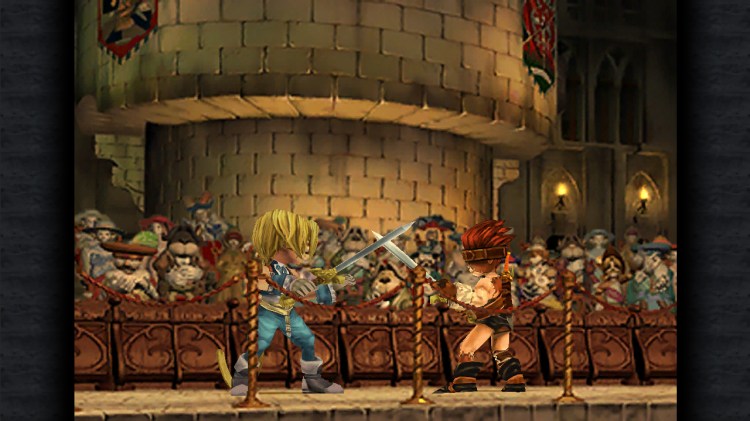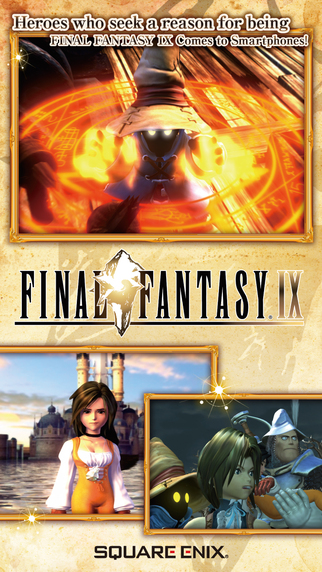When we first played Final Fantasy IX, I don’t think any of us imagined we could one day own the game on our phones.
The original PlayStation version, which came out back in 2000, sold over 5.5 million copies. This mobile port, however, opens the classic up to a new generation of fans via a market that’s worth $34.8 billion a year, according to market research firm Newzoo.
Of course, bringing a complicated role-playing game, especially an old one, to mobile takes work — especially when you’re trying to sell players on a premium experience on a platform where most of the big hits are free-to-play. GamesBeat interviewed Kouichiro Sakamoto, the director of Final Fantasy IX’s mobile version (Final Fantasy IX is also coming out to Steam, but that version isn’t out yet), over email about the challenges of adapting a classic to a touch-based screen.
GamesBeat: How difficult is it to port a game from the original PlayStation to mobile?
Kouichiro Sakamoto: That’s a hard question to answer in a simple way. I believe the difficulty level depends on the two conditions below and how well they are addressed. That’s not to say that having these conditions met makes it easy, but there would probably be a difference in the workload. The two conditions are:
- How much legacy data (program and graphic data) is available
- Whether or not we have developers of the original version still with us
I’m sure the first condition is easy to understand. If we don’t have the original programs, we have to begin coding from scratch, which is like making a brand new game … well, maybe not that far, but it would be far more voluminous and prone to more bugs. It’s the same with graphic data; if the original exists, we could use it as-is, or focus the work on improving the quality. But if it doesn’t exist, we have no choice but to create it, and that means more work.
[Regarding the second point] without an original development member, or someone knowledgeable from that time, it is hard to notice invisible detailed specs, which would lead to a port that is close but not the same thing. If we have a development member from the original version, we are able to better reproduce the secret tricks, hidden items, and invisible parameters. Also, when striving to develop a version that is of higher quality than a simple port, having an original development member present for new proposals is very helpful. This is because they would instantly know what else would be affected, making the process much smoother.
GamesBeat: How did you come around to making specific changes, notably giving the player the option to turn off random battles?
Sakamoto: Final Fantasy IX was released in 2000, so if you were 15 years old at the time, you would be 31 years old today. I think most people find it harder to make the time to play games as they get older — myself included.
So for the players who are looking forward to playing Final Fantasy IX again, but don’t have the time, I thought it might be nice to have a feature that would shorten the playtime. That was my number one reason for turning off the random battle feature.
I also believe recent gamers are used to games that are designed with plenty of tutorials. With this port, we added help text on controls within the game, but I still find overall that the games from those days are not as user-friendly. To have players who feel the same way and want to play this game to the end without giving up on it, we knew we had to take out certain parts that can get tedious, like character growth. So that was the second reason.
When Final Fantasy VII and Final Fantasy VIII were released for the PC, there were some initiatives that were implemented for a wider audience, such as high-speed mode and boost features such as character power-ups. These were received extremely well, so there were no objections to adding features to Final Fantasy IX as well.
The reason we enabled the player to turn encounters on or off is because we wanted the game to be enjoyable not only to users who like the battles, but also to those who like the story. That’s actually why you can’t turn off event battles that relate to the story.
Even if you are a novice at RPGs, or if you couldn’t clear the game before, perhaps you can use the added features to finish the game and witness its emotional ending. The other major change besides the additional features would be the hi-res’ing of the movies and characters. The movies have been up-converted for this port. The character models have also been refined, with textures in higher resolution and looking better.
The reason we took these steps was because we didn’t want the player to change his memories of the original game. Looking back at the PlayStation images now, we see how blocky they are. However, at the time, the player must have thought that they looked amazing. We didn’t want that memory to look better than this port in the player’s eyes, so we took the utmost care to make the screen look fantastic.
GamesBeat: FF7 is already on mobile. Why skip FF8 to go straight to FF9?
Sakamoto: We produced this game to commemorate the 15th anniversary of Final Fantasy IX.
GamesBeat: How well do these mobile versions sell?
Sakamoto: While we cannot touch upon the specifics, the app has been received very positively thanks to our fans.
GamesBeat: How hard is it to make a touchscreen interface work on a phone for an RPG — especially one like FF, with lots of menus?
Sakamoto: It’s very difficult. The team at Silicon Studio, specifically the team in Thailand who developed Final Fantasy IX for us, had some great ideas and put in great work to arrive at the interface we see now, but there were discussions until the very end about whether it would be one tap to confirm or two taps to move and confirm. We ultimately ended up with the two-tap method which results in less mistakes.
If this were a new game, we could limit which data we decide to show, but since this was a port, we couldn’t just delete data that was shown in the original, so the UI [user interface] team was having a very difficult time.
Lastly, it was also very challenging to make enough space for buttons that would be playable on the tiny screen of a smartphone.
GamesBeat: Do you design for touchscreens in such a way that you don’t want the player’s finger to obscure too much of the pretty game on the screen?
Sakamoto: Yes, we certainly try. For example, there are two patterns to moving a character, but with the virtual controller, the corners of the map would be obstructed by your fingers. By implementing a feature that lets you tap where you want to go and automatically move, it simplifies controls and lessens the time your fingers cover up the screen.
Also, because the battle screen covers the UI when you enter battle, there is also a function that turns off all UI displays while you are touching anything other than the commands.
GamesBeat: Any chance we could see this new version of FFIX on consoles?
Sakamoto: While we currently do not have plans to bring the title onto consoles, Final Fantasy IX will be coming to Steam soon.
GamesBeat: Was any work done to enhance the original’s prerendered backgrounds?
Sakamoto: The backgrounds for most of the maps have actually been replaced by hi-res versions of the 2D data used in the original PlayStation version. But because the screen resolution on recent smartphones is so high, it’s hard to tell that the backgrounds have been replaced, which is a shame.
VentureBeat's mission is to be a digital town square for technical decision-makers to gain knowledge about transformative enterprise technology and transact. Learn More




